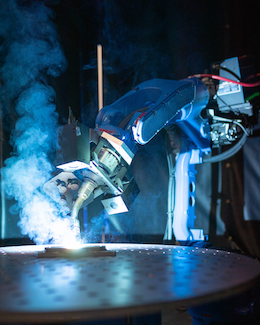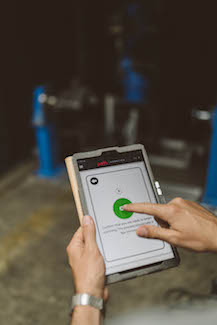The Smarter Way to Tube Weld
Robotic welding is no longer just for low-mix, high-volume production. Robot manufacturers are using artificial intelligence (AI) and machine learning to develop “smart” systems that quickly and easily handle both programming and welding.
Posted: September 24, 2020
ADVANCING AUTOMATION COLUMN
BY JOSH LEATH
In a demanding market with a dearth of qualified welders, maintaining fabrication production of pipes and other unique parts can be difficult. Maintaining productivity becomes even more difficult when you add to the labor challenge the increasing use of higher-strength materials such as P91 steel, duplex and super-duplex stainless steels, nickel-based alloys and aluminum alloys. To gain the flexibility, precision and reliability needed to successfully manage different part dimensions, materials, and fittings, many manufacturers are turning to robotic automation.
Once only ideal for low-mix, high-volume production runs, robotic welding has come a long way, offering exceptional quality enhancements, time savings and cost reductions for a wide variety of applications. Once impeded due to programming downtime and time-consuming changeover, robotic welding for high-mix, low-volume (HMLV) production – particularly of pipes – is becoming a viable reality.
The integration of advanced technology such as through-the-arc seam tracking, feature-rich vision systems, and offline programming have made this possible. Regarding the latter, nearly every element of the fabrication process can now be monitored and controlled, allowing adjustments to robot movement, positioner orientation, torch angle, weld penetration, and wire feed speed.
The Programming Advantage
One major asset in recent years has been the development of artificial intelligence (AI) for programming purposes. Let’s face it: Thanks to various metals, filler metals and part dimensions, welding isn’t always a straightforward process. The experience needed to understand all the facets of welding doesn’t happen overnight, leaving many manufacturers in a pinch when economic expansion comes knocking.
The growing shortage of skilled weld technicians and engineers creates programming bottlenecks a fast-paced fabrication company can ill afford. This has opened the door to AI, where robots make “intelligent” decisions that simulate human thinking and behavior. AI robotics companies have attempted to facilitate programming in several ways:
Machine learning. The process by which the robot teaches itself requires enormous computing power to run through all the scenarios, shapes, interactions, interferences, etc., necessary to determine a successful weld path. While great in theory, it’s extremely expensive to support the processing required. It can’t be done on a local machine; it must be supported by large IT companies.
This can be simplified by creating very specific goals and parameters in your application (i.e. the part shape never changes, but size can).
Part scanning. This process matches a part scan to a predefined CAD model. Sensors help identify any deviation in weld seams, adapting accordingly. Because this method isn’t forgiving of parts that don’t match up to a predefined model, it’s in limited use in welding automation.
Part scanning with offline programming. The user “draws” a weld via offline programming software, which the program uses to teach the robot the designated path. This can be done completely offline and loaded as jobs to the robot or in real time with a “digital twin” via software that matches the robot’s routines.
Seam tracking. The robot uses a vision sensor or a through-arc sensor to determine variations in a weld joint. For pipe or tube welding, the software helps keep the robot weave and weld parameters suitable for the variations in the seam. Because this all happens without additional input from the operator, it’s in wide use today.
The Fully Autonomous Solution
While these methods are viable, they still require an experienced programmer to operate the workcell every time. Plus, they’re not necessarily ideal for the intricacies of pipe welding.
To overcome these challenges, companies in the automation industry have been working to introduce AI into their robotic welding products. From software suites like Hypertherm’s Robotmaster and sensors by Servo-Robot to complete solutions such as Path Robotics’ novel approach combining 6-axis robots with servo-driven positioners, the options available to fabricators continue to evolve and grow.
Packaged as a complete workcell, Path’s solution uses a camera sensor and AI software to determine part shape and weld seam locations, offering faster operation than hybrid or collaborative robot solutions. It’s compatible with the multipass welding needed for heavier parts and can be adapted for different geometries and welding joint configurations of different parts (non-pipe), including tube to plate.
“It’s the first system that uses computer vision and machine learning to recognize on its own what can be welded, determine exactly how to weld, and be able to give a QA analysis of its performance,” says Path Robotics CEO Andrew Lonsberry. “It gives customers the equivalent of skilled welders 24/7 without the need for any robotic experience.”
Frequently used for fabricating specialty automotive components, the system complements the shift toward HMLV production. No matter the part variety or tolerance, the system’s ability to autonomously generate motion and understand where to place the perfect weld without programming or custom fixtures is game- changing.
Not only is this type of AI fabrication ideal for tube-to-plate applications, it also shows great potential when applied to pipe welding. The use of collaborative robots in the welding workspace can also reduce workcell space requirements, which are often unwieldly with pipe welding applications.
The Easy Choice
Manufacturers experiencing significant downtime and subsequent lack of production due to programming issues for the welding of pipes or other unique parts may want to consider investing in a fully automated solution that provides the flexibility, reliability, and quality needed to effectively address consumer demands. Similarly, for those looking for a more robust return on investment, moving to an intelligent system that handles both programming and welding will more than likely prove instrumental in reaching productivity gains within a shorter payback period.

















